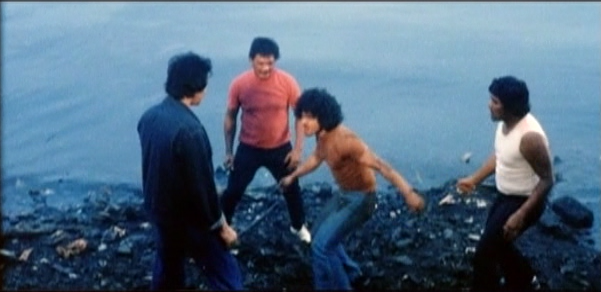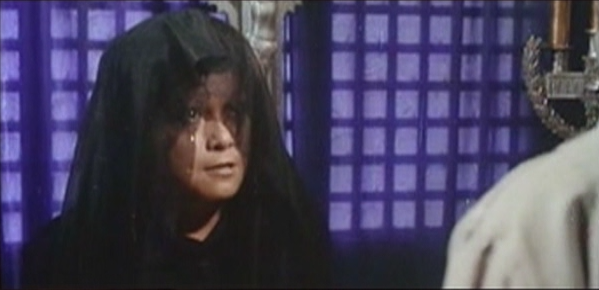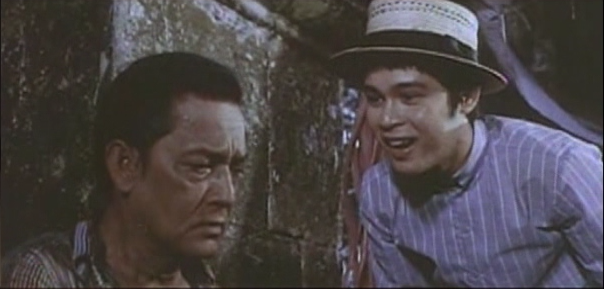Five films Imelda shouldn’t have let you see
Former First Lady Imelda Marcos is often credited for putting Philippine art on a pedestal. To an extent, this is true. Imelda defined herself as an art patroness extraordinaire by establishing the Philippine Cultural Center and the Metro Manila Film Festival to promote “the good and beautiful” side of life to Filipinos. She made artists feel important, showered them with attention, accolades, money, opportunities to study abroad. But the promotion of one type of art necessarily meant the suppression of another, the kind that detailed the harsh life under the Marcos regime. While foreign ballets and musicians were lauded, provocative art was gagged. “[Imelda] was very partial to Western culture,” said film historian Nick Deocampo. “Parang naging kolonyal ang pamantasan ng sining, at eletista [rin].” The impressionist painter Henri Matisse once said, “creativity takes courage.” Filipinos took censorship as a challenge and found subtle ways to infiltrate mainstream, state-censored media. Through films, they alluded to the inhuman conditions of the dictatorship, galvanized the people for Ferdinand Marcos’ eventual demise, and today are still treasured as part of the Philippines’ golden age of cinema. In Howie Severino’s I-Witness documentary, “Ganito Kami Noong Martial Law,” he showed the struggles of writers and filmmakers to find an audience during a time of oppressive censorship. “Actually, my docu on the surface was about how filmmakers were among the few artists who could show the truth during martial law,” says Severino. “But on another level, martial law films are part of a Pinoy yearning to find out who he or she is, which started long before martial law, and persisted even during a very repressive period.” Perhaps in a roundabout way, Imelda Marcos is one of the greatest patrons of art: an integral part of her legacy are the brutally honest films that her husband's martial law regime unknowingly pushed artists to create. Here are five of the most important ones: Insiang (1976)  Hilda Coronel plays the titular character, an impoverished laundrywoman who plots revenge against her mother’s rapist lover. Directed by Lino Brocka, it was the first Filipino film to be feted at the Cannes Film Festival. A film's unadulterated depiction of poverty stood out in stark relief against Marcos' sanitized Metro Manila, where Imelda was building walls to keep shanties and settlements out of public view. “The First Lady said it did not project [a] ‘beautiful’ Philippines,” said its producer, Ruby Tiong Tan. “She wanted to project a beautiful Philippines to the world. But this movie was set all in the slums, and nowhere beautiful.” At the 1976 MMFF, Coronel bagged the award for Best Actress, while Ruel Vernal and Mona Lisa II were awarded Best Supporting Actor and Actress, respectively. Despite Imelda’s protestations, Tan smuggled the film out of the country in her luggage and allowed the world to see what many consider to be Brocka’s greatest masterpiece. Minsa’y Isang Gamu-Gamo (1976)
Hilda Coronel plays the titular character, an impoverished laundrywoman who plots revenge against her mother’s rapist lover. Directed by Lino Brocka, it was the first Filipino film to be feted at the Cannes Film Festival. A film's unadulterated depiction of poverty stood out in stark relief against Marcos' sanitized Metro Manila, where Imelda was building walls to keep shanties and settlements out of public view. “The First Lady said it did not project [a] ‘beautiful’ Philippines,” said its producer, Ruby Tiong Tan. “She wanted to project a beautiful Philippines to the world. But this movie was set all in the slums, and nowhere beautiful.” At the 1976 MMFF, Coronel bagged the award for Best Actress, while Ruel Vernal and Mona Lisa II were awarded Best Supporting Actor and Actress, respectively. Despite Imelda’s protestations, Tan smuggled the film out of the country in her luggage and allowed the world to see what many consider to be Brocka’s greatest masterpiece. Minsa’y Isang Gamu-Gamo (1976)  Perhaps the film is best known for Nora Aunor’s immortal line, “My brother is not a pig!” Moreover, it was a film that decried the presence of U.S. military bases in the country. At the start, Aunor’s family sees America as a land of boundless opportunity, but gradually becomes disillusioned after a series of abuses by visiting American servicemen. Rumor has it that Ferdinand Marcos did not approve of the film’s production, but Aunor’s friendship with Imelda helped convince the First Couple otherwise. Directed by Lupita Aquino-Kashiwahara, “Gamu-Gamo” won prizes for Best Editing, Best Cinematography and Best Story at the 1976 MMFF. Ganito Kami Noon, Paano Kayo Ngayon? (1976)
Perhaps the film is best known for Nora Aunor’s immortal line, “My brother is not a pig!” Moreover, it was a film that decried the presence of U.S. military bases in the country. At the start, Aunor’s family sees America as a land of boundless opportunity, but gradually becomes disillusioned after a series of abuses by visiting American servicemen. Rumor has it that Ferdinand Marcos did not approve of the film’s production, but Aunor’s friendship with Imelda helped convince the First Couple otherwise. Directed by Lupita Aquino-Kashiwahara, “Gamu-Gamo” won prizes for Best Editing, Best Cinematography and Best Story at the 1976 MMFF. Ganito Kami Noon, Paano Kayo Ngayon? (1976)  “Ganito Kami Noon” takes place at the turn of the 20th century, when the Philippines was passed from the hands from one colonizer to another. In the middle of it all was Kulas Ocampo, played by Christopher De Leon, who experienced one misfortune after another as Filipinos grappled with their identity and nationhood. “Parang unang Forrest Gump,” said De Leon of his character. “Inosente, ang daming pinagdaanan pero 'di siya nagdamdam. Nagpagamit siya ... nilapastangan na siya, ngingiti-ngiti pa siya. Parang Pilipino na may delubyo na nga, nakukuha paring ngumiti.” The film was a runaway success during that year’s MMFF, claiming six of 12 awards, including Best Film, De Leon as Best Actor, and Eddie Romero as Best Director. Bayan Ko: Kapit sa Patalim (1985)
“Ganito Kami Noon” takes place at the turn of the 20th century, when the Philippines was passed from the hands from one colonizer to another. In the middle of it all was Kulas Ocampo, played by Christopher De Leon, who experienced one misfortune after another as Filipinos grappled with their identity and nationhood. “Parang unang Forrest Gump,” said De Leon of his character. “Inosente, ang daming pinagdaanan pero 'di siya nagdamdam. Nagpagamit siya ... nilapastangan na siya, ngingiti-ngiti pa siya. Parang Pilipino na may delubyo na nga, nakukuha paring ngumiti.” The film was a runaway success during that year’s MMFF, claiming six of 12 awards, including Best Film, De Leon as Best Actor, and Eddie Romero as Best Director. Bayan Ko: Kapit sa Patalim (1985)  This film was another Brocka masterpiece which was smuggled into the Cannes Film Festival in 1984. The film—starring Phillip Salvador, Gina Alajar, Carmi Martin, and Raul Aragon—ties fictional characters to real-life labor and social upheavals in the early 70’s to sharply criticize the Marcos administration. Upon discovering its allusions, Brocka was arrested for his work. “‘Bayan Ko’ had already achieved a certain stature next to the national anthem as the major song of protest,” explained Tiongson. “If you see that on film, ibang usapan 'yun.” “Very controversial [ang ‘Bayan Ko’] dahil during that time patay na si Ninoy at maraming tensyon na nangyayari sa gobyerno, so ito ay nakakadagdag ng tensyon,” said Martin. Sakada (1976)
This film was another Brocka masterpiece which was smuggled into the Cannes Film Festival in 1984. The film—starring Phillip Salvador, Gina Alajar, Carmi Martin, and Raul Aragon—ties fictional characters to real-life labor and social upheavals in the early 70’s to sharply criticize the Marcos administration. Upon discovering its allusions, Brocka was arrested for his work. “‘Bayan Ko’ had already achieved a certain stature next to the national anthem as the major song of protest,” explained Tiongson. “If you see that on film, ibang usapan 'yun.” “Very controversial [ang ‘Bayan Ko’] dahil during that time patay na si Ninoy at maraming tensyon na nangyayari sa gobyerno, so ito ay nakakadagdag ng tensyon,” said Martin. Sakada (1976)  Director Behn Cervantes succinctly described “Sakada” as a film “about seasonal workers who don’t have a good life, and [their] hacienderos ... excessively rich Filipinos who enjoy life without deserving the enjoyment of life.” Audiences responded to the thinly-veiled criticism of power with bold rounds of applause after screenings, said Cervantes. It surprised the military that people were so approving of a film that didn’t speak well of Martial Law. The film enjoyed a three-week run before it was pulled out of cinemas on Marcos’ orders, and remaining copies, including Cervantes', were seized. Though he was arrested for his work, Cervantes had no regrets. “The artists were able to express themselves because martial law was in place,” he said, paradoxically. “You had something to speak against and the enemies were so real, like Marcos, Imelda, and their family.”—HS/PF, GMA News
Director Behn Cervantes succinctly described “Sakada” as a film “about seasonal workers who don’t have a good life, and [their] hacienderos ... excessively rich Filipinos who enjoy life without deserving the enjoyment of life.” Audiences responded to the thinly-veiled criticism of power with bold rounds of applause after screenings, said Cervantes. It surprised the military that people were so approving of a film that didn’t speak well of Martial Law. The film enjoyed a three-week run before it was pulled out of cinemas on Marcos’ orders, and remaining copies, including Cervantes', were seized. Though he was arrested for his work, Cervantes had no regrets. “The artists were able to express themselves because martial law was in place,” he said, paradoxically. “You had something to speak against and the enemies were so real, like Marcos, Imelda, and their family.”—HS/PF, GMA News




